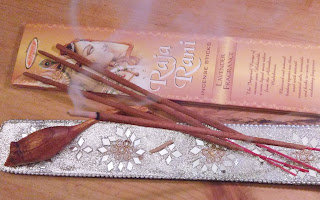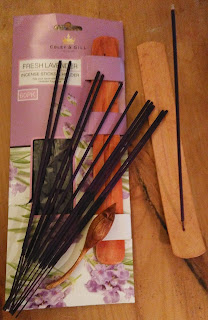I'm exploring resins and how to burn them. Following advice in
this guide from the founder of Legacy Icons I broke my charcoal disc into bits. But then I found difficulty in getting the resin to stay on the charcoal. In fact most fell onto the stones. Some larger pieces stayed in place, but the smaller pieces rolled off. To make any piece stay, I had to hold it in place until it got sticky. But, as you may note in the picture, Goloka's frankincense resin is very small, so it was a tricky operation. After a while I returned to using my burner, following advice I'd picked up to use a bit of foil in order to keep the hot plate clean. But the foil reduces the heat exchange, and that impacts negatively on the aroma, as it burns too slowly, so I ended up putting the incense directly on the metal plate of my burner, and that got the most satisfying results. I'm still to explore further, and it's all a learning curve, but I'm thinking that putting the resin directly on the burner hot plate is the way to go. Not all advice you get is helpful (or perhaps not clearly understood....)
Anyway, I got this frankincense resin from Goloka because I trust Goloka. It cost £3.95 for 50g from
JustAromatherapy, who offer free delivery for orders over £35, and 10% discount for orders over £50 (so, as I did order over £50 worth, this only cost me £3.55). There is a musty, earthy, citric tang to it which is quite interesting, but is not the scent I associate with frankincense. When burning (on charcoal and burner) there is a scorching scent, which is not exactly pleasant. Every now and again I get a whiff of frankincense. Hmmm. I dig out some
frankincense I'd bought from The Scenter at £2.49 for 30g a few years back. The scent in the bag is exactly what I expect from frankincense, but when burned it also has that scorched smell. Hmmm. I'm not yet quite getting how to burn resin. I get out the Prinknash resin I was burning and try that. Ah. This actually smells more pleasant. Not frankincense, but something orangy, but at least its pleasant. I pop some myrrh from JustAromatherapy onto my charcoal. Not impressed. Now a bit on the burner.
 |
| The mouse is back.... |
I've been playing around with burning resin for a few days now. And I'm not exactly having a great time. I have these really positive memories of when I first burned resin, so I'm willing to keep trying. But a number of experiences over the years have been more problematic than positive. During today's experiments I knocked a piece of burning charcoal unto my desk and slightly scorched a cloth, then later dropped a piece of burning resin onto my shirt, then onto the floor. And at some point my fast burning burner stopped working. Hmmmm. Lighting a joss stick is so much easier!
Date: April 2019 Score: (Today's experience was not positive) 15
***






































.jpg)

















